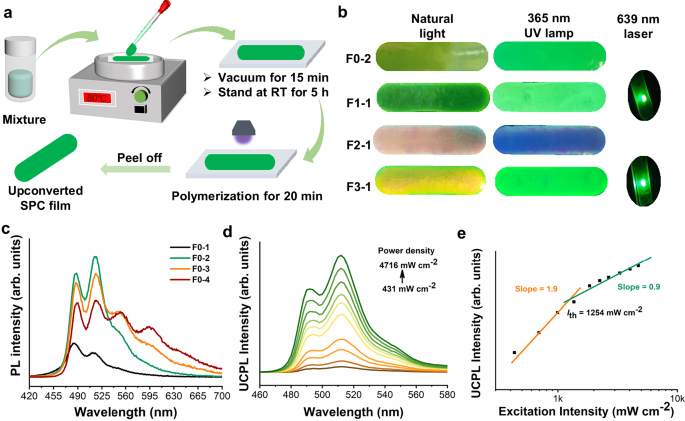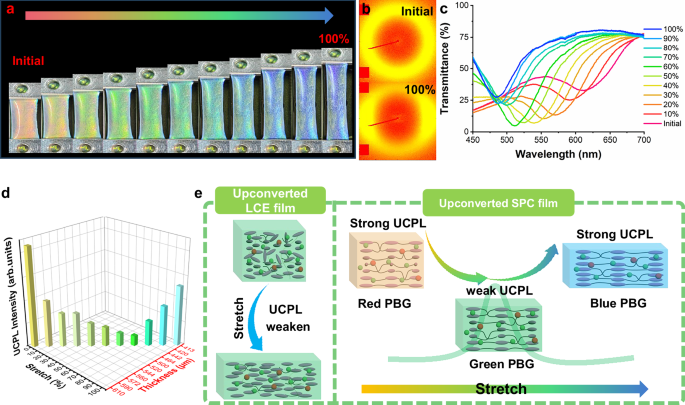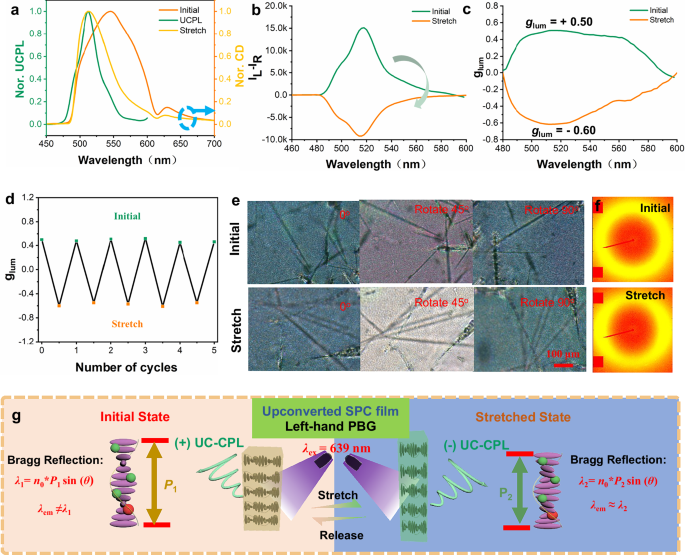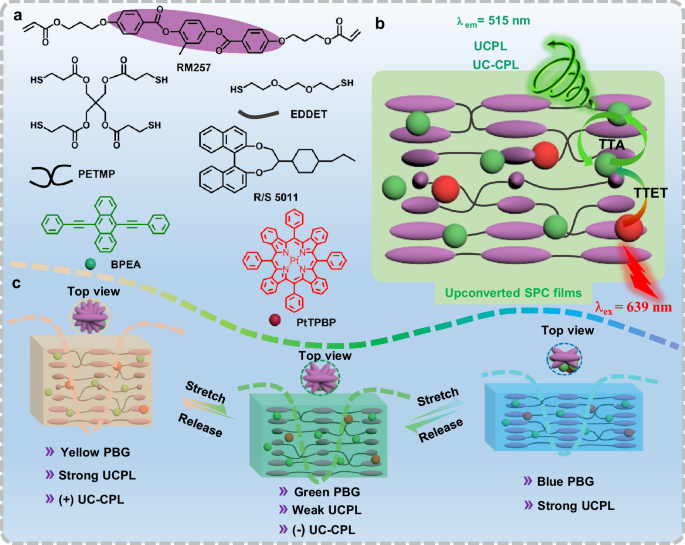Optimization of upconverted SPC films preparation and UCPL
We prepared the BPEA/PtTPBP-loaded upconverted SPC films by using a straightforward anisotropic swelling method combined with a two-stage thiol-acrylate addition and in-situ photopolymerization. The preparation process of the film and the appearance of some tested films are shown in Fig. 2a, b. For instance, LCEs with 0.5 wt% BPEA (F0-2), LCEs with BPEA/PtTPBP (F1-1), LCEs with S-5011 (F2-1), LCEs with S-5011 and BPEA/PtTPBP (F3-1). The green UCPL of F1-1 and F3-1 films is observed upon excitation of 639 nm laser in ambient air. While this wide agreement that oxygen can quench triplet excited state, this preparation process is conducive to removing oxygen from the film, such as vacuuming and polymerization. The Michael addition reaction and generated free radicals can react with active oxygen species during the polymerization process, leading to the formation of inactive peroxy radicals. This reaction effectively reduces the concentration of oxygen within the film, thereby creating an environment favorable for achieving TTA-UC61,62,63.
Fig. 2: Preparation of thin films and UCPL.
a Schematic illustration of fabricating process for upconverted SPC films via a facile anisotropic deswelling method that combined two-stage thiol-acrylate Michael addition and photopolymerization reactions. b The photos of films under natural light, 365 nm UV lamp, and 639 nm laser. c Fluorescence spectra of BPEA at different concentrations in liquid crystal elastomer (LCE) films. (λex = 400 nm) d UCPL spectra of BPEA/PtTPBP (50:1) with different incident power density of 639 nm laser in LCE film; e Double-logarithmic plots of the UCPL intensity of BPEA/PtTPBP (50:1) as a function of excitation intensity of the 639 nm laser.
To achieve optimal TTA-UC, we determined the ideal concentration of BPEA and the ratio of BPEA to PtTPBP through photoluminescence tests. The absorption and fluorescence spectra of BPEA and PtTPBP are shown in Supplementary Fig. 1. The concentration of the luminescent molecules plays a significant role in determining both the UCPL efficiency and spectrum in upconverted LCEs. At a low concentration, TTET from PtTPBP to BPEA is insufficient, while BPEA aggregates at an excessively high concentration, which paradoxically reduces luminescence efficiency. We prepared a series of achiral LCEs films containing varying mass fractions of BPEA at concentrations of 0.1 (F0-1), 0.5 (F0-2), 1.0 (F0-3), and 2.0 (F0-4) wt% and performed a comprehensive analysis of their optical performance (Supplementary Table 1). The fluorescence spectra indicate that the F0-1 exhibits distinct luminescence peaks at 488 and 515 nm (Fig. 2c). As the concentration of BPEA increases to 0.5 wt%, the luminescence peak at 488 nm weakens, while the peak at 515 nm increases due to self-absorption. As the concentration increases further in the films F0-3 and F0-4, distinct luminescence peaks appear at 556 nm and 596 nm, respectively. We speculate that this is due to the aggregation of BPEA molecules. We conducted verification through the color of the film and the texture under polarizing microscope (POM). The film turns yellow, and a clear red crystal is observed under POM (Supplementary Fig. 2). These results indicate the formation of aggregated states. Considering the impact of both luminescence efficiency and aggregation in the films, we determined the optimal concentration of BPEA is 0.5 wt%. As for the optimization of the PtTPBP content, we selected molar ratios of 50:1 (F1-1), 100:1 (F1-2), and 150:1 (F1-3) for the upconversion pair of BPEA/PtTPBP. The optical path for testing UCPL is shown in Supplementary Fig. 3, under irradiation with a 639 nm laser, remarkable UCPL signal is observed peaking at 515 nm (Fig. 2d and Supplementary Fig. 4a, c). The double-logarithmic plots of UCPL intensity as a function of excitation density exhibit the slope of fitted result transitioning from ~2 to ~1 (Fig. 2e and Supplementary Figs. 4b, d), confirming the TTA mechanism. In addition, the UCPL lifetime at 515 nm of F1-1, F1-2, and F1-3 is estimated to be 377, 295, and 339 μs, respectively, consistent with the long-lived triplet state annihilation mechanism (Supplementary Fig. 5). F1-1 shows a threshold excitation intensity of 1254 mW cm−2, demonstrating it requires the lowest excitation intensity to achieve saturated upconversion efficiency among these three sets of samples. Therefore, we selected a BPEA concentration of 0.5 wt% in F1-1 and a molar ratio of BPEA to PtTPBP at 50:1 for the following investigation.
Dynamic regulation of UCPL in upconverted SPC films
To reveal the mechanical and optical properties of the prepared elastomer films under stretched operation, stress-strain and stretching-dependent UCPL tests were performed. We define the direction of the tensile force along the x-axis, the width of the film along the y-axis, and the thickness along the z-axis (Supplementary Fig. 6). The films F1-1, F2-1 and F3-1 exhibit excellent stress-strain characteristics at room temperature, with an elongation exceeding 100%, laying a foundation for subsequent experiments (Supplementary Fig. 7). Subsequently, the UCPL of the films F1-1 under mechanical stress was examined (Supplementary Fig. 8). The UCPL intensity gradually decreases as the tensile strain along the x-axis increases, which reveals that the tensile deformation of the film is detrimental to the upconversion performance.
The continuous suppression of UCPL during stretching harms the practical applications of upconverted LCEs films. We thus introduced chiral molecule S-5011 into the elastomer to prepare SPC films possessing helical superstructure, with the aim of enhancing UCPL through the PBG edge. The edge of the PBG can enhance the coupling effect and the photonic density of states51,52,64,65. To confirm such a scenario, the changes in the PBG position of F2-1 were investigated during stretching. As shown in Fig. 3a, the F2-1 exhibits notable discoloration at different elongation states. The color of the film changed from red via green to blue with continuous mechanical stretching. The reason for the blue shift of F2-1 color is that the reduction of the film thickness along the z-axis leads to a decrease in helical pitch (Supplementary Fig. 9), resulting in the PBG position moving to a short wavelength. Remarkably, this entire stretch-and-release process is fully reversible, with no noticeable delay between mechanical relaxation and color recovery (Supplementary Fig. 10). To further elucidate the mechanochromic mechanism of the stretched F2-1, qualitative analysis was conducted using POM and wide-angle X-ray diffraction (WAXD) measurements. As shown in Supplementary Fig. 11a, in the initial state, when the film F2-1 is rotated by 45° and 90°, there is no obvious change in the POM texture. When the elongation is 100%, the POM images show periodic changes from the dark field to the bright field with the film F2-1 rotates at 45° intervals, indicating that the texture of F2-1 and the arrangement of liquid crystal units deform along the mechanical stretching direction. Furthermore, as the F2-1 stretches, the WAXD patterns change from a ring to a pair of arcs (Fig. 3b). By performing an azimuthal angle integration of WAXD, no obvious peak is observed in the initial film, while after stretching, diffraction peaks appeared near 0° (360°) and 180° (Supplementary Fig. 11b). These results indicate that the polydomain structure in the initial F2-1 transitions to a monodomain structure with the stretched modulation. To gain insights into the mechanochromic response of F2-1, transmittance spectra were recorded. The position of the transmittance peak continuously shifts from 610 to 482 nm during uniaxial stretching (Fig. 3c). We further incorporated right-handed circularly polarized filter (R-CPF) and left-handed circularly polarized filter (L-CPF) into the transmittance test for the uniaxial strain experiment (Supplementary Fig. 12). The initial F2-1 exhibits characteristic transmittance only when the R-CPF is applied. Interestingly, the film starts reflecting certain wavelength in the L-CPF channel when stretched uniaxially by more than 40%. This result indicates that the F2-1 gradually transitions from a polydomain helical structure to a monodomain stratified structure, approaching a 1D Bragg reflector state that reflects both left- and right-handed circularly polarized light. Consequently, the PBG does not disappear when the elongation is less than 100%, allowing us to fully utilize the PBG-edge enhancing effect to enhance TTA-based UCPL.
Fig. 3: The basic properties of various films under dynamic stretching.
a Photographs of a SPC film F2-1 being mechanically stretched. b The initial SPC film F2-1 corresponding wide-angle X-ray diffraction (WAXD) patterns of polydomain structure, and the 100% strained film corresponding WAXD patterns of monodomain structure. c Transmittance spectra of the initial F2-1 at various strains (from 0% to 100%) with no polarizer. d The relationship between different tensile lengths, thickness, and UCPL intensity of film F3-1. The original length of the above test films is 20 mm, and each stretch is 2 mm, a bar chart column represents a single measurement, λex = 639 nm, λem = 515 nm. e Schematic diagram of tensile changes of thin films with and without PBG.
We studied the TTA-UC properties of upconverted SPC film F3-1 during the uniaxial tensile process. The stress-dependent UCPL spectra reveals that the UCPL intensity initially decreases and then increases during the F3-1 stretching process (Fig. 3d and Supplementary Fig. 13). The UCPL intensity decreases from the initial value until the elongation reaches 70%, when it reaches the minimum UCPL intensity. When the elongation exceeds 70%, the UCPL increases. We found that at this point of 70% elongation, the position of PBG is near 515 nm (Supplementary Fig. 14), which corresponds to the emission wavelength of UCPL. When the elongation exceeds 70%, the PBG shifts towards a short wavelength; correspondingly, the UCPL peak locates at the edge of the PBG, enabling the enhancement of emission intensity. Furthermore, we conducted a study on the lifetime and upconversion efficiency (ΦUC) of F3-1 at different stretching length positions (Supplementary Fig. 15 and Supplementary Table 3). The UCPL lifetime increases from the initial 189 μs to 268 μs accompanied by a decrease in ΦUC when stretched to 70%, and then drops to 164 μs when reaching the band edge at 100% elongation (while the ΦUC increases). For F1-1 films without PBG, the UCPL lifetime tends to stabilize from the initial 159 μs after stretched by 70%, while the ΦUC continues to decrease. These results clearly indicate that the variation of the photonic density of states near the PBG improves the UCPL intensity through the resonance mechanism, providing strong experimental evidence for the role of the PBG-edge enhancing effect in UCPL51,52,64,65. Regarding the difference in the variation trend of UCPL between F1-1 and F3-1 during the stretching process, the schematic diagram in Fig. 3e illustrates the influence of two elastomers on UCPL. In the F1-1, the UCPL decreases gradually throughout the stretching process. On the other hand, when helical superstructure is formed in F3-1, the increase in UCPL is that the PBG-edge enhancing effect during the stretching process. These results prove our hypothesis that the band-edge enhancement effect of upconverted SPC film can mitigate the loss of UCPL intensity caused by the tensile deformation of the film.
Dynamic regulation of UC-CPL in upconverted SPC films
Encouraging by the excellent regulating properties of the PBG, we further investigated the UC-CPL performance of the upconverted SPC film under mechanical force. In chiral liquid crystal-based photonic crystals, the emission of circularly polarized light possesses distinct selectivity66,67. For instance, the left-handed photonic crystals film can reflect left-circularly polarized light while allowing the transmittance of right-circularly polarized light (Supplementary Fig. 16). We tested the PBG of the F3-2 film by circular dichroism (CD) spectroscopy (Fig. 4a). The CD spectra of initial film show a PBG centering at ~545 nm, while it shifts to ~514 nm after stretching. These results suggest that the degree of overlap between the PBG and UCPL peaks of BPEA can be dynamically adjusted. We established an optical testing setup by turning the angles between the quarter-wave plate and polarizer to measure UC-CPL intensity (Supplementary Fig. 17). Using the formula IUC-CPL = IL − IR, where the IL and IR denote the intensity of left-handed and right-handed circularly polarized light, respectively, data presented in Fig. 4b shows that the UC-CPL inverts from a positive to a negative signal with the stretching of upconverted SPC film, corresponding to a transition from left-handed to right-handed UC-CPL. Furthermore, by applying the glum calculation formula glum = 2 × (IL − IR)/(IL + IR), we obtained the spectra of glum versus wavelength shown in Fig. 4c. The glum corresponding to the emission peak of initial film is +0.50, while stretching of the film inverts it to −0.60, confirming that tuning the PBG effectively alters the circular polarity of the UC-CPL. The glum values of initial and stretched states remain almost unchanged under 5 times stretching-releasing cycles in the same test conditions (Fig. 4d), proving good fatigue resistance of the film. Furthermore, we investigated the structural evolution of upconverted SPC film during stretching process through POM and WAXD. When the F3-2 film is stretched to 30% elongation, it exhibits a change in its structural color upon being rotated to an angle of 45°, while its brightness remains nearly constant (Fig. 4e). As the film is rotated further to 90°, its color reverts to that observed at the initial 0° position. This optical behavior is analogous to that of the unstretched film, suggesting that the liquid crystal texture is not significantly altered by the 30% strain. Figure 4f shows a circular ring in the initial state. After stretching of the film, only slight changes on the orientation distribution are observed (Supplementary Fig. 18). These experimental results indicate that the structural change of the stretched film is not significant, thus the influence of the linear polarization effect during the stretching process on UC-CPL is negligible. Based on these observations, a mechanism of UC-CPL inversion is depicted in Fig. 4g. According to the Bragg reflection, the reflected wavelength (λ) can be calculated by the formula λ = n0*P sin(θ), where P is the pitch of the helical structure, n0 is the average refractive index of the material, and θ is the angle of the incident light68. Here we define the wavelengths of PBG in the initial and stretched states as λ1 and λ2, respectively, and the peak position of UCPL as λem. In the initial state, PBG is far from the UCPL wavelength (λ1 ≠ λem), thus BPEA/PtTPBP emits left-handed UC-CPL upon excitation. On the other hand, after stretching, the PBG shifts and coincides with the position of the emission wavelength (λ2 ≈ λem). The system reflects the left-handed light while transmitting the right-handed light, thus generating the right-handed UC-CPL.
Fig. 4: Dynamic regulation of UC-CPL.
a The relationship between PBG and UCPL wavelengths under stretching of upconverted SPC film F3-2. The position of the luminescent peak is fixed, and PBG is dynamically adjusted with the stretching b UC-CPL spectra of initial and stretched film. The initial and stretched intensities are calculated according to the formula IUC-CPL = IL − IR. c Distribution of luminescence dissymmetry factor (glum) values of initial and stretched film as a function of wavelength. The glum values are calculated from glum = 2 × (IL − IR)/(IL + IR). d Reversible changes of glum values (515 nm) against repeated stretching and releasing cycles of upconverted SPC film F3-2. e POM images of the upconverted SPC film F3-2 in transmission mode under crossed polarizers before and after being stretched (Scale bar = 100 μm). f The upconverted SPC film F3-2 corresponding WAXD in the initial state and stretched state. g Schematic diagram of dynamic regulation of UC-CPL by upconverted SPC film. The initial state is left-handed UC-CPL, and the state after stretching is right-handed UC-CPL.
The application of upconverted SPC films in information display and encryption
We explored the potential applications of upconverted SPC films in dynamic information encryption and decryption based on their mechanically tunable color and UC-CPL characteristics. Especially, inspired by the display and concealment of information manipulated by the self-regulation mechanism of butterfly wings, a motion that dynamically conceals (upon folding) and reveals (upon spreading) their inherent structural coloration (Fig. 5a), we designed a manipulable application for displaying and hiding information. Initially, a butterfly-shaped mold was created using a laser marking device, followed by the infusion of the F3-2 formulation and subsequent polymerization, resulting in upconverted SPC films with butterfly shape, which serves as a medium for information encoding (Fig. 5b). At this point, information changes under static conditions are displayed. Under natural light, the butterfly-shaped films display a yellow structural color (I). Upon irradiation with a 639 nm laser, bright green UCPL (II) is observed, accompanied by distinct bright-dark variations under the CPFs. Weak luminescence is observed through the R-CPF (III), while strong luminescence is observed through the L-CPF (IV), confirming the emission of left-handed UC-CPL. We further manipulated the butterfly membrane. The structural color transitions from yellow to green (I’). When excited by 639 nm light, the UCPL becomes weaker (II’) compared to state (II). However, the opposite phenomenon is observed through CPFs, with strong UC-CPL observed through the R-CPF (III’) and weak UC-CPL observed through the L-CPF (IV’). This demonstrates that these films not only enable structural color modulation through mechanical manipulation but also facilitate the regulation of UC-CPL, offering alternative insights into the dynamic applications of smart materials. Furthermore, the application of these materials in binary-encoded information encryption, utilizing both structural colors and UCPL, was investigated (Fig. 5c). In this scheme, the binary digit “0” is represented by the F-R-BPEA (F4-1) film, while “1” is encoded using the F-S-BPEA/PtTPBP (F3-2) film. These distinct films were integrated into a matrix to encode the binary message “CPL”. Under ambient natural light, no discernible difference is apparent between the encoded regions. Similarly, while fluorescence is observable under 365 nm UV irradiation, the encrypted information remains concealed. However, the encoded message “CPL” can be revealed through specific decryption protocols. The primary decryption method involves observing changes in the structural color of the chiral photonic crystal films when viewed through a R-CPF. Under these conditions, bright areas indicate “1” and dark areas indicate “0”. A secondary decryption pathway utilizes UCPL. Upon excitation at 639 nm, films containing the BPEA/PtTPBP TTA-UC components emit distinct UCPL spots, thereby allowing the retrieval of the “CPL” encoded information. This innovative approach leverages the unique optical characteristics of chiral photonic crystals and UCPL, presenting an alternative strategy for advanced information encryption.
Fig. 5: The applications of upconverted SPC films in dynamic information encryption and decryption.
a In nature, butterflies display information by steering its wings manipulating their wings, dynamically conceals (I: upon folding) and reveals (I’: upon spreading) their inherent structural coloration. (Photo by the author). b Bionic patterning of upconverted SPC films inspired by butterflies (Butterfly wings upon folding correspond to the initial state of the film, and butterfly wings upon spreading correspond to the stretch state of the film, by artificially manipulating the film, different brightness and darkness UCPL can be exhibited at different circularly polarized filters); And group changes observed under different conditions. (I, I’ are photos taken in natural light, among them, I is in the initial state and I’ is in the stretched state; Ⅱ, Ⅲ, Ⅳ, Ⅱ‘, Ⅲ‘, Ⅳ‘ are photos taken under 639 nm excitation and 580 nm short-pass filter, among them, Ⅱ, Ⅲ, Ⅳ are in the initial state and Ⅱ‘, Ⅲ‘, Ⅳ‘ are in the stretched state). c The application of binary-encoded information encryption utilizing structural colors and UCPL.

